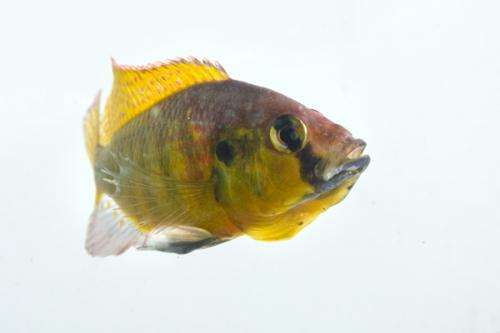Cichlid fish genome helps tell story of adaptive evolution

(Phys.org) —Roughly 40 million years ago, a handful of species of fish from the Nile River went into three lakes in Africa and experienced an unusual flurry of evolution. In one of these lakes as many as 500 new species emerged in fewer than 100,000 years.
Now, an international team of scientists, including Stanford biologists who study these cichlid fish, has sequenced the genomes of five of these species, providing unique insight into the genetic drivers of diversification and adaptation in all vertebrates.
The findings are published in the current issue of Nature.
For decades biologists have identified African cichlid fish as an interesting family of animals for studying how species variation works. The 2,000-plus species of related fish in the African lakes alone represent tremendous morphological variations that allow them to live in niche habitats.
Some fish have adapted to eat the scales of other fish. Others have adaptations that allow them to live among rocks and eat prey, shells included. Several species adapted to reproducing in turbulent waters by carrying fertilized eggs in their mouths until they hatch.
To get at how this spectacular "adaptive radiation" – the process by which multiple species evolve from an ancestor through adaptation – occurred so quickly among cichlid fish, the scientists analyzed the genomes of these five species, starting with the Nile tilapia, which represented the ancestral lineage.
Then they looked at four East African species: one from a river near Lake Tanganyika; a species that colonized Lake Tanganyika 10 million to 20 million years ago; a cichlid fish that entered Lake Malawi 5 million years ago; and a species from Lake Victoria, where the fish radiated between 15,000 and 100,000 years ago.
Genetic clues
Analysis of the genomes revealed a remarkably high rate of gene duplication across all species. Gene duplication occurs when cellular hardware creates two copies of a gene. These events are an essential source of genetic novelty leading to evolutionary innovation. One copy, freed from selection, could adapt to a new function, or be turned off or even serve as a "spare" if the original gene is damaged. Alternatively, the original function can be divided, giving different roles to each copy of the gene.
Eventually, an environmental pressure could arise that could only be surmounted by calling the archived copy back into duty. Because it is already part of the animal's genome, it can spread more quickly than an entirely novel gene.
"It's like having a larger deck of cards to play with when adapting to a new set of circumstances," said co-author Russell Fernald, a professor of biology at Stanford. "The species somehow finds way to exploit its expanded genome to adapt to novel situations."
The scientists found a sixfold increase above normal rates of gene duplication among the species, and although they don't yet know what triggered this, they suspect it drove the incredibly rapid rate of diversification among cichlid fish.
Additionally, through the work of co-author Rosa Alcazar, a postdoctoral research fellow in Fernald's lab, the sequencing project revealed 40 new microRNA-encoding genes, short sequences of single-stranded genetic information that help regulate gene expression.
The expression of the microRNAs complemented those of the genes they are hypothesized to regulate, leading to the intriguing possibility that they are also involved in stabilizing or refining expression patterns that have arisen during species radiation.
Novel microRNAs regulating conserved genes shows how they can hijack an established system and use it in novel ways. Conversely, the researchers found that some conserved microRNA precursors generate slightly different versions of mature sequences – suggesting they might target different pathways or the same pathway in a different way.
"This knowledge will help us understand how microRNAs fine-tune gene expression and how they co-opt new targets to regulate," Alcazar said. "We are currently mapping microRNA expression in a cichlid brain and finding some have specific expression in regions known to regulate social behavior."
Solving a constellation of genes
One thing that is clear is that the story doesn't end with sequencing the genomes of the fish.
"We've come to learn that sequencing a genome is possibly like producing a list of words in a Shakespeare play – it's just the words and can't tell us the plot," Fernald said.
The big challenge, he said, is to look at specific events in a species evolution and begin to understand what drives certain genes to become expressed, and how and why they exert changes. For instance, what genes turn on to tell a fish to eat scales and then modify its jaw to take advantage of this food source?
Fernald said that scientists recognize that it might not be a single gene making this type of decision, but rather a constellation of genes – or microRNAs or other factors – that, when expressed together, can control a behavior. His research group is currently studying fish with specific mating behaviors, cross-breeding them, seeing which behaviors are conserved and then analyzing those fishes' genomes for clues as to which genes controlled the behavioral change.
"Genetics is so highly conserved across species that by doing this type of analysis in animals where we can control variables very closely, we can begin to understand how genes control behavior in other vertebrates," Fernald said.
More information: "The genomic substrate for adaptive radiation in African cichlid fish." David Brawand et al. Nature 513, 375–381 (18 September 2014) DOI: 10.1038/nature13726
Journal information: Nature
Provided by Stanford University
















